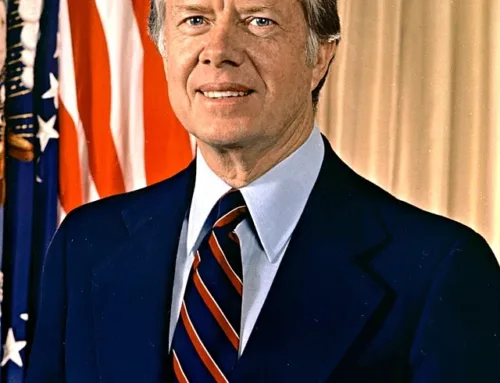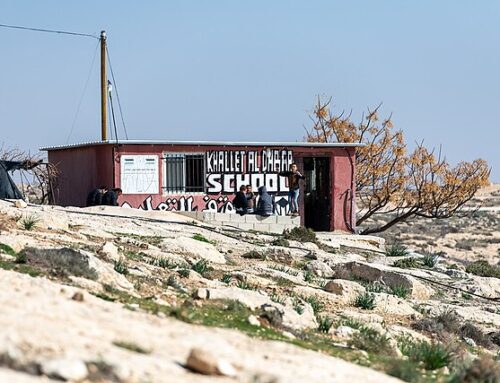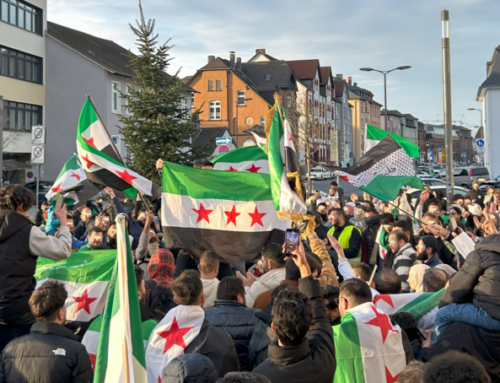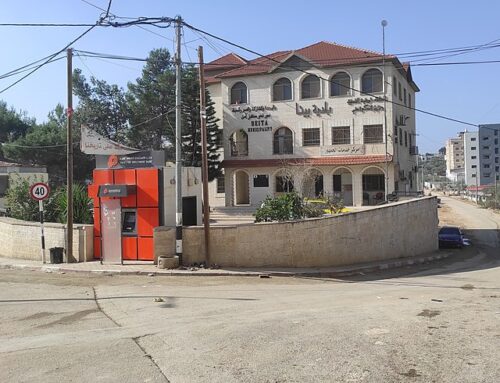 |
| The sign reads in Hebrew and Arabic: “We want a bilingual school” |
A few weeks ago, wandering around Tel Aviv in search of a long, overdue, lunch, I happened to pass by the entrance to the Tel Aviv City Hall, where a small protest was taking place. Curious, I engaged with a few of the protestors in conversation to discover that they were a group of parents living in the Tel Aviv-Yaffo area pushing for official bilingual education in Yaffo, a promise originally made but not kept by the municipality. After speaking to a number of participants, I was put in contact with someone who could give me a more thorough understanding of the issue.
A few days later, as I was heading out the door to a conference that happened to be dealing with the very same issues, I received a call from Hagit Ya’ari of the Israel Women’s Network, who was kind enough to give me her personal account of the situation. Admittedly, the conversation seemed a bit anti-climactic, as only days before the Tel Aviv municipality finally agreed to the opening of a Hebrew-Arabic first-grade class in the next school year.
Hagit came into this circle of both Arab and Jewish parents during a meeting in Florentine, Tel Aviv, after being invited by some friends to participate. Her reasons for stressing a bilingual education for her children were varied. She had already been sending them to a “mixed-school,” which should not be confused with one which is bilingual; the former contains a mixed population of Jewish and Arab students, but is far more likely to stress Israeli Jewish education, Hebrew language, and an overarching Jewish narrative. In short, it gives its Jewish students an undeniable advantage. The latter, as she explained, contains not only a bilingual curriculum, but gives equal weight to a Palestinian Arab narrative and, depending on the students’ demographic makeup, also provides weight to Christianity, Islam or the Druze religion.
Most importantly, a shared environment starting at an early age is far more likely to curtail the racism that has been so endemic over the last few years. She noted the complete lack of contact between the two populations, a self-imposed segregation that seemed to be getting worse and worse as the years go by. Jews, she felt, either looked at the Arabs living among them as traitors to be scorned, or simply an invisible population to be ignored. During even the worst of times, however, in particular this last summer’s war which seemed to bring out the worst in society, their binational group maintained its harmony, “like an oasis”. Ultimately, the students themselves weren’t the only ones to benefit from the experience. “I like to say that we have 6,000 students”, she told me. “1,000 of them attend classes and then go home to their family members, which will hopefully have a ripple effect on their behavior”.
When I asked about the breakdown of demographics, particularly in regards to their economic status, she explained that while the Jewish participants were of a somewhat stereotypical upper-middle class, liberal background, the Arabs were more varied, running the gamut from working class to well-to-do, established families from Yaffo. Despite the stereotypes of a separatist-minded people seeking to have as little as possible to do with the Jewish majority, she said, the Arab minority is in fact interested in learning Hebrew and integrating into wider Israeli society; they simply want to do so on their own terms.
This alienation and demonization of the other isn’t exclusive to inter-ethnic relationships within the Green Line; it mirrors an ongoing problem occurring between Israeli Jews and Palestinian Arabs residing in Gaza and the West Bank. Ever since the outbreak of the Second Intifada, direct communication between the two populations has continued to dwindle to a point in which West Bank Palestinians have been forced to view Israeli Jews exclusively through the prism of military occupier or violent, hilltop youth, while Gazans, particularly after the last war, associate Israel with war and destruction. Just as the activity of person-to-person contact is of great importance amongst Jews and Arabs within Israel, it is perhaps of even greater importance in the latter situation.
Working in the past at the Peres Center on such issues, there were, admittedly moments of cynicism regarding such activities; donors and visitors to the center sometimes came across as starry-eyed do-gooders, looking to fund a vanity project, but with little understanding of how to actually cultivate a spirit of coexistence between the two sides. In retrospect, I realize just how wrong I was. In times of absolute stagnation, as we’ve seen in the last six years when negotiations came to a standstill, the most ordinary type of contact is essential to prevent filling the existing vacuum with extremist and bigoted rhetoric.
This alienation and demonization of the other isn’t exclusive to inter-ethnic relationships within the Green Line; it mirrors an ongoing problem occurring between Israeli Jews and Palestinian Arabs residing in Gaza and the West Bank. Ever since the outbreak of the Second Intifada, direct communication between the two populations has continued to dwindle to a point in which West Bank Palestinians have been forced to view Israeli Jews exclusively through the prism of military occupier or violent, hilltop youth, while Gazans, particularly after the last war, associate Israel with war and destruction. Just as the activity of person-to-person contact is of great importance amongst Jews and Arabs within Israel, it is perhaps of even greater importance in the latter situation.
Working in the past at the Peres Center on such issues, there were, admittedly moments of cynicism regarding such activities; donors and visitors to the center sometimes came across as starry-eyed do-gooders, looking to fund a vanity project, but with little understanding of how to actually cultivate a spirit of coexistence between the two sides. In retrospect, I realize just how wrong I was. In times of absolute stagnation, as we’ve seen in the last six years when negotiations came to a standstill, the most ordinary type of contact is essential to prevent filling the existing vacuum with extremist and bigoted rhetoric.
Later that evening, at the Forum for Bilingual Education and Coexistence, I heard many panelists touch on a number of Hagit’s reasons for the importance for this type of education: integration, desegregation, an end to demonization of the other. I also learned some disturbing facts, including the frighteningly high number of Jewish students who would refuse to live in the same building as an Arab, and an almost equal number of Arab students who questioned the veracity of the Holocaust.
Two points struck me as particularly interesting. The first was purely utilitarian, that a push for bilingual education should be framed in the economic benefits it would bring to those Israeli Jews interested in doing business in a post-peace accord Middle East (provided that it ever comes to fruition). The second had far more urgency. “What’s the point” one panelist argued, “of continuing these types of person-to-person meetings between children if the government continues to sanction this type of racist talk and demonization?”
And indeed, in the last six years, we’ve seen that the greatest culprit of racist, unabashed incitement has come from the government, and not from its fringes: calls for transfer of whole populations, for the wanton destruction of Gaza, accusations of disloyalty, are all from elements within the ruling coalition. Just as we see continuing incitement against the left, so too do we see it against Israeli Arabs; and if even the official face of the state has no qualms about speaking in this way and normalizing this behavior, what hope do educators have in preventing this hatred from forming in the first place? The better question is: what is preventing us from making certain that the right does not form the next government?






Wonderful